PONTIAC BONNEVILLE 1996 Service Manual
Manufacturer: PONTIAC, Model Year: 1996, Model line: BONNEVILLE, Model: PONTIAC BONNEVILLE 1996Pages: 387, PDF Size: 18.71 MB
Page 41 of 387
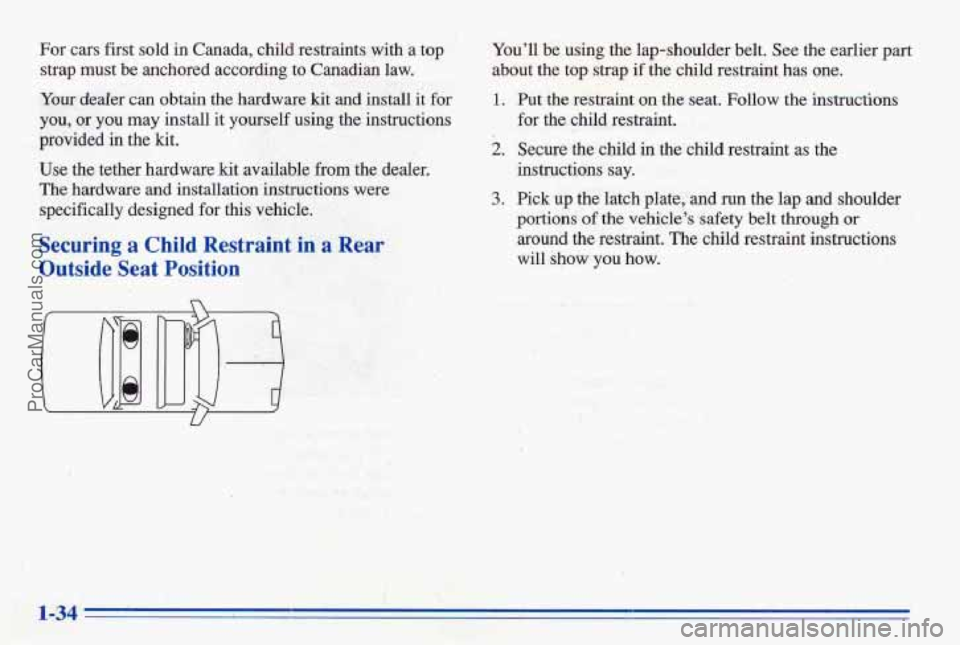
For cars first sold in Canada, child restraints with a top You'll be using the lap-shoulder b'elt. See the earlier part
strap must be anchored according
to Canadian law. about the top strap if the child restraint has one.
Yam de&r can obtain the hardware kit and instdl it for 1.
you, or you may install it yourself using the htnxctioqs
provided in the
kit.
Use the tether hardware kit available from the dealer.
The hardware and installation instructions were
specifically designed for this vehicle.
2.
3.
Securing a Child Restraint in a Rear
Outside Seat Position
n
u
Put the restraint on the seat Follow the iilstmctions
for the child restraint.
Secure
the child in the child restraint as the
instructions say.
Pick up the latch plate, and
run the lap and shoulder
portions of the vehicle's safety belt through QT
around the restraint. The child restraint instructions
will
show you how.
ProCarManuals.com
Page 42 of 387

4. Tilt the latch plate to adjust the belt if needed.
If the shoulder belt goes in front of the child’s face or
neck, put
it behind the child restraint.
5. Buckle the belt. Make sure the release button is
positioned
so you would be able to unbuckle the
safety belt quickly if you ever had to.
ProCarManuals.com
Page 43 of 387
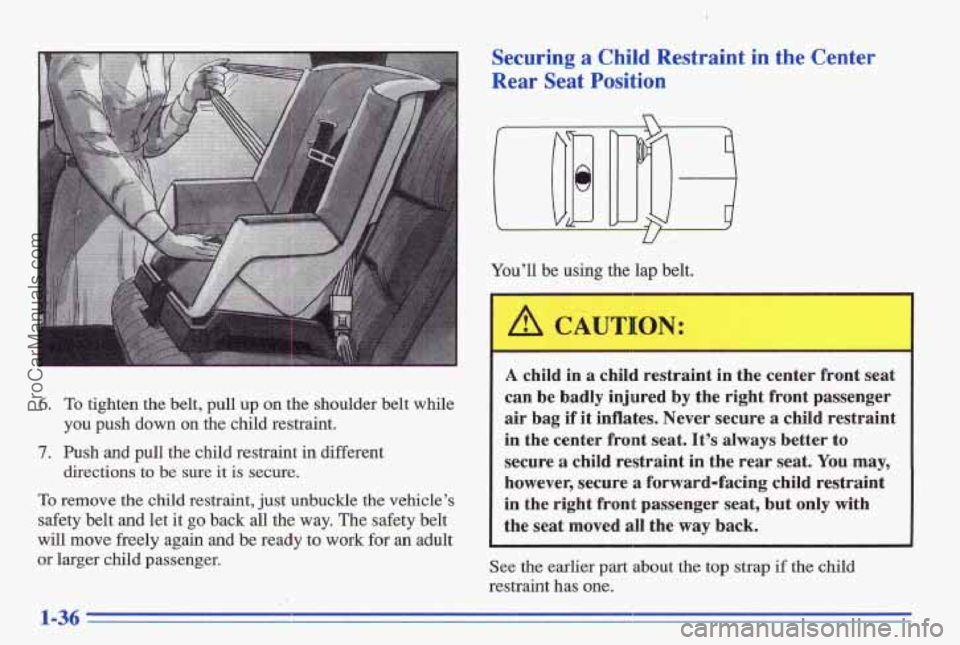
6. To tighten the belt, pull up on the shoulder belt while
7. Push and pull the child restraint in different
you push down on the child restraint.
directions to
be sure it is secure.
To remove the child restraint, just unbuckle the vehicle’s
safety belt
and let it go back all the way. The safety belt
will move freely again and be ready to work for an adult
or larger child passenger.
Securing a Child Restraint in the Center
Rear Seat Position
You’ll be using the lap belt.
bA CAUTION:
I
A child in a child restraint in the center front seat
can be badly injured by the right front passenger
air bag
if it inflates. Never secure a child restraint
in the center front seat. It’s always better
to
secure a child restraint in the rear seat. You may,
however, secure a forward-facing child restraint
in the sight front passenger seat, but only with
the seat moved all the way back.
See the earlier part about the top strap if the child
restraint has one.
1-36
ProCarManuals.com
Page 44 of 387
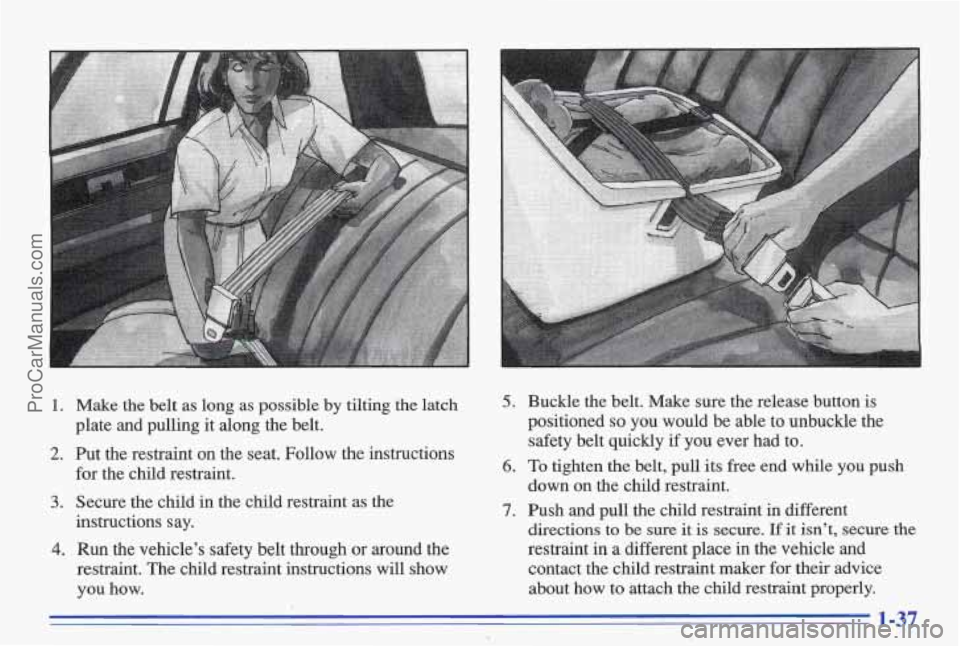
1. Make the belt as long as possible by tilting the latch
plate and pulling it along the belt.
2. Put the restraint on the seat. Follow the instructions
for the child restraint.
3. Secure the child in the child restraint as the
instructions say.
4. Run the vehicle's safety belt through or around the
restraint. The child restraint instructions
will show
you how.
S. Buckle the belt. Make sure the release button is
positioned so you would be able to unbuckle the
safety belt quickly
if you ever had to.
5. To tighten the belt, pull its free end while you push
down on the child restraint.
1. Push and pull the child restraint in different
directions
to be sure it is secure. If it isn't, secure the
restraint in
a different place in the vehicle and
contact the child restraint maker for their advice
about how to attach the child restraint properly.
1-37
ProCarManuals.com
Page 45 of 387

To remove the child restraint, just unbuckle the vehicle’s
safety belt.
It will be ready to work for an adult or larger
child passenger.
Securingta Child Restraint in the Right
Front Seat Position
Your vehicle has a right front passenger air bag. Never
put a.rear-facing child restraint in this seat, Here’s why:
A child in a rear-facing child restraint can be
seriously injured if the right front passenger’s air
bag inflates.
This is because the back of a
rear-facing child restraint would be very clos’e to
the inflating air bag. Always ‘secure a rear-facing
child restraint
in the rear seat.
You’ll be using the lap-shoulder belt. See the earlier part
about the
top strap if the child restraint has one.
1. Because your vehicle has a right front passenger air
bag, always move the seat as far back as it will go
before securing a forward-facing child restraint. (See
“Seats”
in the Index.)
for
the child restraint.
2. Put the restraint on the seat. Follow the instructions
3. Secure the child in the child restraint as the
imtructipns say.
4. Pick up the latch plate, and run the lap and shoulder
portions of the vehicle’s safety
belt through or
around the restraint. The child restraint instructions
will show you how.
If the shoulder belt goes in front of the child’s face or
neck, put
it behind the child restraint.
1 ?Q
ProCarManuals.com
Page 46 of 387
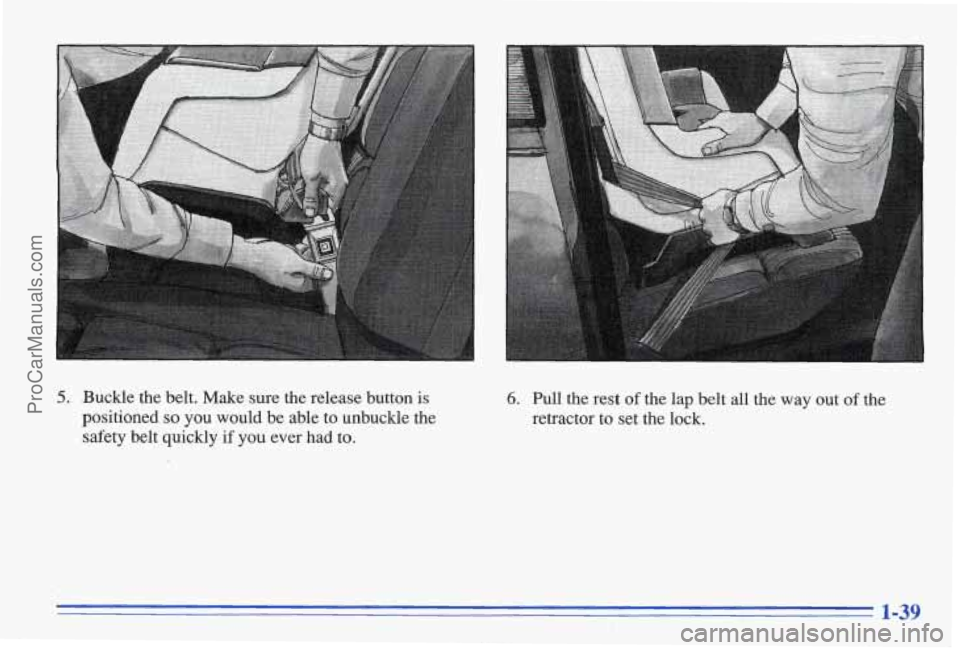
5. Buckle the belt. Make sure the release button is
positioned so you would be able to unbuckle the
safety belt quickly if you ever had to.
6. Pull the rest of the lap belt all the way out of the
retractor to set the lock.
1-39
ProCarManuals.com
Page 47 of 387
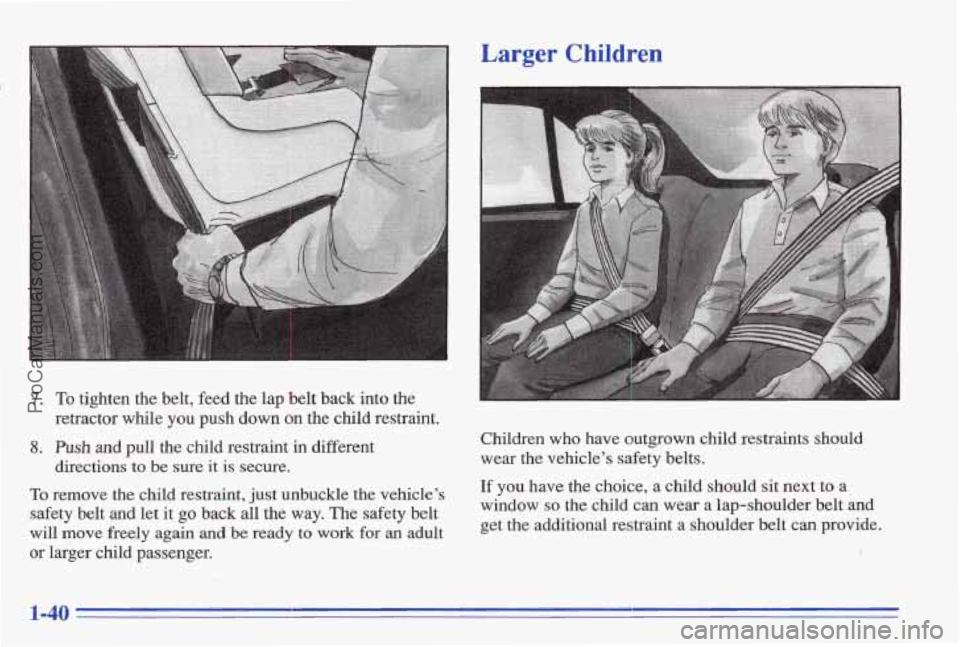
7. To tighten the belt, feed the lap belt back into the
8. Push and pull the child restraint in different
retractor while you push down on the child restraint.
directions to
be sure it
is secure.
Larger Children
Children who have outgrown child restraints should
wear the vehicle’s safety b’elts.
To remove the child restraint, just unbuckle the vehicle’s If you have the choice, a child should sit next to a
safety belt
and let it go back all the way. The safety belt window so the child can wear a lap-shoulder belt and
will move freely again and
be ready to work for an adult get the additional restraint a shoulder belt can provide.
or larger child passenger. I
1-40
ProCarManuals.com
Page 48 of 387
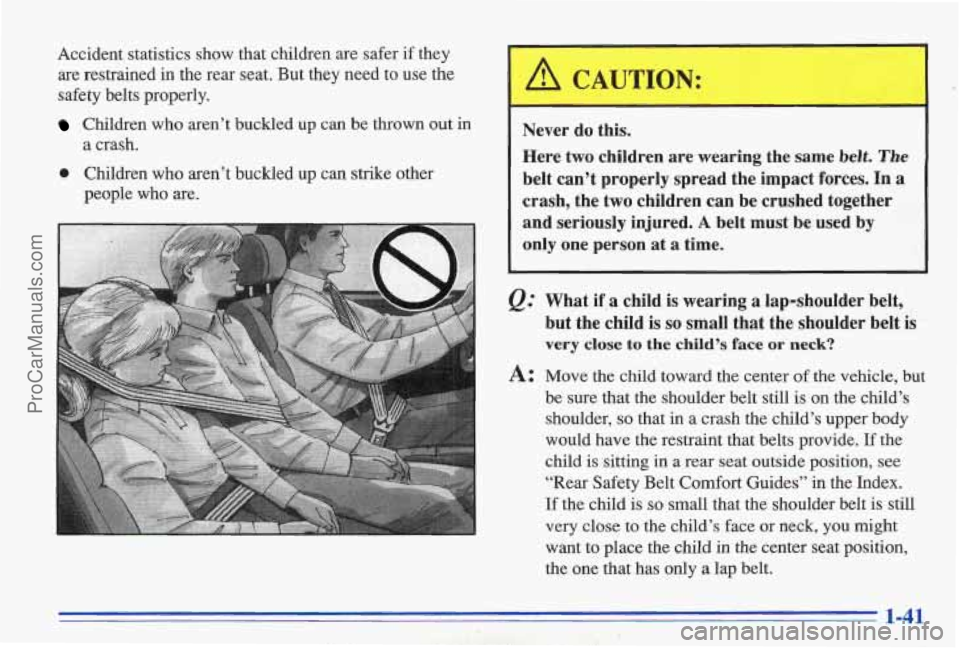
Accident statistics show that children are safer if they
are restrained in the rear seat. But they need to use the
safety belts properly.
Children who aren’t buckled up can be thrown out in
0 Children who aren’t buckled up can strike other
a crash.
people who
are.
Never do this.
Here
two children are wearing the same belt. The
belt can’t properly spread the impact forces. In a
crash, the two children can be crushed together
and seriously injured.
A belt must be used by
only one person at a time.
@ What if,a child is wearing a lap-shoulder belt,
but the child
is so small that the shoulder belt is
very close to the child’s face or neck?
A: Move the child toward the center of the vehicle, but
be sure that the shoulder belt still
is on the child’s
shoulder,
so that in a crash the child’s upper body
would have the restraint that belts provide.
If the
child is sitting in a rear seat outside position, see
“Rear Safety Belt Comfort Guides”
in the Index.
If the child is so small that the shoulder belt is still
very close to the child’s face or neck, you might
want to place the child in the center seat position,
the one that has only
a lap belt.
1-41 , I ProCarManuals.com
Page 49 of 387

I Never do this.
Here
a child is sitting in a seat that has a
lap-shoulder belt, but the shoulder part is behind
the child.
If the child wears the belt in this way, in
a crash the child might sli’de under the belt. The
belt’s force would then
be applied right on the
child’s abdomen. That could
cause ‘serious or
fatal injuria
Wherever the child sits, the lap portion of the belt
should be
worn low and snug on the hips, just touching
the child’s
thighs. This applies belt force to the child’s
pelvic bones
in a crash. I
ProCarManuals.com
Page 50 of 387
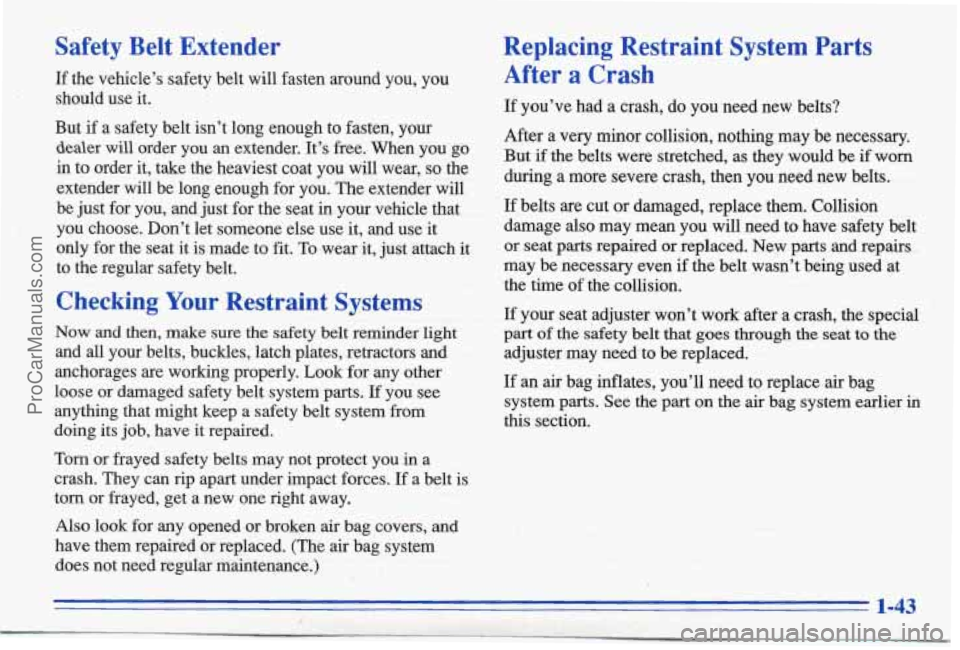
Safety Belt Extender
If the vehicle’s safety belt will fasten around you, you
should use it.
But
if a safety belt isn’t long enough to fasten, your
dealer
will order you an extender. It’s free. When you go
in to order it, take the heaviest coat you will wear,
so the
extender
will be long enough for you. The extender will
be just for you, and just for the seat
in your vehicle that
you choose. Don’t let someone else use it, and use it
only for the seat it is made to fit.
To wear it, just attach it
to the regular safety belt.
Checking Your Restraint Systems
Now and then, make sure the safety belt reminder light
and all your belts, buckles, latch plates, retractors and
anchorages are working properly. Look for any other
loose or damaged safety belt system parts.
If you see
anything that might keep
a safety belt system from
doing its
job, have it repaired.
Torn or frayed safety belts may not protect you in a
crash. They can rip apart under impact forces. If a belt is
tom or frayed, get a new one right away.
Also look for any opened OF broken air bag covers, and
have them repaired or replaced. (The
air bag system
does not need regular maintenance.)
i
Replacing Restraint System Parts After
a Crash
If you’ve had a crash, do you need new belts?
After a
very minor collision, nothing may be necessary.
But
if the belts were stretched, as they would be if worn
during a more severe crash, then you need new belts.
If b’elts are cut or damaged, replace them. Collision
damage also may mean you
will need to have safety belt
or
seat parts repaired or replaced. New parts and repairs
may be necessary even if the belt wasn’t being used at
the time
of the collision.
If your seat adjuster won’t work after a crash, the special
part
of the safety belt that goes through the seat to the
adjuster may need,to be replaced.
If
an air bag inflates, you’ll need to replace air bag
system parts, See the part
on the air bag system earlier in
this section.
ProCarManuals.com